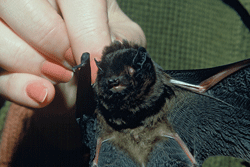New sonar devices to aid bat bounce-back
New sonar devices to aid bat bounce-back
A long-tailed breed of little Hamilton natives, who navigate by sonar, is threatened with extinction by hungry rats and loss of suitable trees.
So Environment Waikato (EW) and Hamilton City Council (HCC), along with the Riverlea Environment Society, have launched a new conservation initiative called Project Echo to help Hamilton’s population of long-tailed bats spread their wings more widely.
In recent years, bats have been detected in Hammond Bush, Riverlea, at the city’s southern end. But recent research by Waikato University MSc student Darren Le Roux has shown that bats are in fact more wide spread along the southern urban-rural interface of Hamilton City than previously thought. Bats are now also known to use the Hamilton Gardens, Hamilton Cemetery and Sandford Park.
This local resident population of bats, whose numbers are uncertain, makes Hamilton one of the only confirmed New Zealand cities to support this threatened mammal species.
Now Project Echo is trying to find out if the bats are also roosting in other parts of the city to help with efforts to support the species in Hamilton.
The project involves HCC funding Riverlea Environment Society’s purchase of bat detection devices from Britain which convert the sonar signal bats send out into a sound audible to humans.
The bats live in small cavities in large, native and exotic trees, including dead trees, and are threatened by marauding rats and loss of suitable habitat. People who suspect bats may be present on their properties can contact EW to arrange to borrow the detection equipment free of charge.
“If people think they have bats on their sections or are about to remove a large or dead tree they can contact the regional council,” said the chair of EW’s regional pest management committee Simon Friar, whose responsibilities also include biodiversity.
“We’ll then contact the society and arrange the loan of the equipment, collect any information from residents about what they find, and share the info with the society and HCC.
“This sort of information can help in deciding where to carry out rat control and where to maintain or create suitable tree habitat.
“In situations where landowners still needed to remove vegetation even after bats were discovered, we could use a variety of methods to encourage the bats to transfer to a new location before trees were removed.”
People interested in borrowing the equipment should contact EW biosecurity officer Ben Paris on 0800 800 401. More information about Project Echo is available online at http://www.ew.govt.nz/Projects/Project-Echo/ A bat sighting form is available on this website.
Picture credit: Crown Copyright: Department of ConservationTe Papa Atawhai (August 1973), Photographer: J L. Kendrick PLEASE NOTE:


